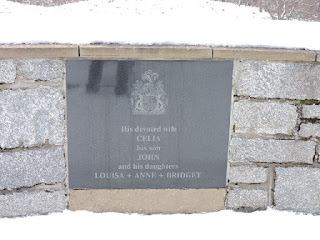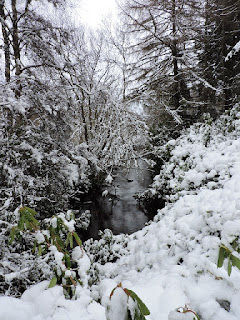WALKING IN A WINTER WONDERLAND AT MOY
For our first walk of 2018 and the first walk of our thirteenth year, we went to Moy to walk round the loch. Astonishingly, we had not done this walk before, despite it being pretty close to home, and a circular walk at that. It's not often that we walk in snow as deep as we encountered either. Parts of the walk were like a Polar expedition and others were like a winter wonderland. The place we parked the cars was a bit churned up and brown from gritting. It was also floody breezing, so we did not tarry long, being desperate to get moving and to generate some heat.
Sharon and Sandra had both had brown snowballs thrown at their heads at the same time, which was some feat. I don't know why Sharon had been cast out of the circle, but she does seem a little wistful and lonely. Aaaw.
Walkers welcome the sign said. We were all eagerly expecting a roaring log fire in some little inglenook, rustic bar with mulled wine and hot toddies. Oh, how disappointed we were to be on this occasion.
Very shortly we were walking through the Tundra - wind blasted, forlorn and abandoned by every living thing except for the hardiest of grasses.
In reality, we were walking along a track beside a field, but the wind was very cold and lazy - it went through you rather than round you.
Luckily it wasn't long before we turned a corner and we were sheltered from the wind. It wasn't exactly tropical, but it was much more pleasant.
Our path now followed the outflow from Loch Moy. The inflow is called the Moy Burn, but the outflow is the Funtack Burn. Remarkably, there is a significant bit of history attached to the Funtack Burn! Oh yes there is!
Moy is the home of the Mackintoshes and the island in the middle of the loch was their stronghold. The implacable enemies of the Mackintoshes were the Cummings (Comyns), who occupied Rait Castle near Auldearn. The Cummings thought to block the Funtack Burn and so flood the Mackintosh stronghold on the island. They made the fatal, and I mean fatal, error of camping downstream of the dam. They also failed to keep watch and a Mackintosh man rowed over to the dam from the island, removed the blockage and so the Cummings were swept to their deaths.
The snow had caught in the tree branches and twigs, like so much candy floss.
The whole of Loch Moy was frozen over and the ice looked thick enough to carry some weight, but nobody was willing to put that to the test.
There were some fault lines in the ice that would suggest a bit of skating was likely to end in disaster.
Across the ice we could see the island in the loch that was the Mackintosh stronghold. There is a tall obelisk visible from all around the island. This was erected by Dame Margaret Mackintosh in 1824 to commemorate her husband Sir Aeneas Mackintosh who had died in 1820 and had been the 23rd Chief of the Clan. He had actually raised a company of Highlanders in America and fought in the American War of Independence. He was captured at the Battle of Brooklyn in 1776. He was eventually released by the Americans and returned to Moy in 1783. He built the original Moy Hall, but when he died in 1820 he and Margaret had no children and the titles passed to his cousin Alexander.
There were occasionally signs on the ice that looked like tracks, but we couldn't get close enough to see if someone or something had crossed over the frozen loch.
We continued along the south west shore of the loch, looking a bit as if we had stepped into an old black and white movie. there was really little colour in the landscape
There was a bit of a feeling of being in a James Fenimore Cooper book.
What lay under this protuberance in the ice? Once again, nobody was willing to go and find out. It looks almost like a miniature volcano, but it probably wasn't.
Every time you drive down the A9, you can see this zig-zag on the hillside. It marks the planting of Larch in the middle of the coniferous forest. Larch are the only conifers to lose their needles in winter and so they stand out. The needles are a bit lighter in colour than the surrounding trees and so you can see them all year round. there is a zig-zag track marked on the Ordnance Survey map, but I cannot be sure that they follow the route of that. Maybe they were just planted by some fun-loving forester, or else they had some left over from some other forest.
A closer view of the monument to Sir Aeneas. When we were there we did not appreciate that the island was actually largely man-made and that there were significant remains of a street, large fortified house and gardens on the island. It was the stronghold of the Mackintoshes and had been used in times of trouble for centuries. The walled garden had been established in 1665. The island was thought to have been used by Bonnie Prince Charlie before he went to Culloden. But, then again, Prince Charlie is said to have been everywhere at some point in time.
Time to stop for one of Maureen's sweeties.
We met a dog that quite fancied a sweetie too.
A view across to Moy Parish Church. We decided against going for a closer look. Luckily someone else had already had a closer look. The church was built in 1765, probably on the site of an earlier pre-reformation church. This is backed up by a survey in the 1990's that found that the rafters in the roof date back to 1680-1700 and each of them is adzed and numbered with Roman numerals.
We louped a fence to get to another memorial.
Passing a hibernating snake on the way...
...to the site of Lachlan's memorial.
We stood around for only a short time to look at the memorial as it was blowing a gale and it was whipping the snow across the site, meaning we were all freezing where we stood.
Some of us actually knew Lachlan, or The Mackintosh as he was known. He was councillor and the Chairman of the Roads and Transport Committee of Highland Regional Council. He was one of the old school patrician landowners who had a sense of public duty that went beyond the more self service that we see in today's politicians, local, national and international. He was clearly held in high esteem by his family, friends and Clan.
I braved the wicked wind to take this photo of the view from the memorial. It takes in the site of Moy Hall and this was, no doubt, deliberate.
On we went until we joined the old A9 for a short distance. It was here that we came across this refugee from Christmas. Dave did talk to it, but could get no sense. We really needed Susan and Robin to talk turkey.
Off the road we passed by the South Lodge to Moy Hall. This was built about 1803, when the second Moy Hall was built to replace the original hall dating from about 1700. This was the Hall that replaced the stronghold on the island.
There was a nice skeletal tree in the grounds of the Lodge, but it wasn't the same age as the building. Having said that, there were a lot of very old, very tall trees about that might well be that sort of age.
The snow was a bit thick and deeper here - a bit Good King Wenceslas.
As always, there was a bridge for a bridge photo. In this case, I had to wade through deep snow to get into a position to take the photo.
Shortly after the bridge photo, it was time for lunch in the comparative shelter of some large trees. The lower branches of the trees also served to hang our sticks and gloves on. A stick tree, in fact.
Maureen was the stick guardian.
We did not linger long over lunch as it was still pretty cold, especially when you were not walking. Little did we know we were about to walk where no man had walked before, or at least recently, and that walking would not keep us warm.
Our route took us to Moy Hall. Not the prettiest of buildings it was actually built in 1957 - so some of the Dinosaurs are younger than the Hall. This building replaced the one that matched the gate lodge we saw earlier.
This is the front elevation of the Hall. Still not wonderful, but better than the side elevation we were first faced with. Given the ornate and frankly, over the top, design of the gate lodge we can only guess what the previous Hall looked like.
Well, actually, we don't have to guess because the National Record of the Historic Environment has a set of drawings prepared for alterations that were to be carried out at the Hall in the 1890's. An altogether more individual building, if a little too rococo for some tastes.
Next we crossed over the fields to the front of the Hall.The wind was whipping off the loch and straight through us as we ploughed through the snow in the style, but not any of the grace, of Arctic explorers.
Sharon had to be rescued after going up to her thigh in snow. Unfortunately, I was suffering from mild frostbite and could not get the camera ready to take a photo of her moment of distress.
She was obviously so distressed, that she had to rush to the toilets - which were gents!
Maureen and Sue looked on, bemused.
Clearly someone was preparing for really deep snow.
Or else the shed had been blown all the way from Kansas, with or without Dorothy and Toto, and had fallen straight down to wedge in between the two tree trunks.
There was no open water for the ducks to use.
We trudged up the hill a bit, to where you got some nice views back to the north and west.
The view.
From here we also had a good view of the smaller of the two islands in the loch - Eilean nan Clach. Island of Stone, or more oddly - island of the testicles - but that sounds like balls to me. This is thought to be man-made, possibly a crannog. It was used as a prison by the Mackintoshes until 1746.
Another view.
It was as we made our way down from the viewpoint that I noticed Sharon was out of focus. She had lost her glasses somewhere in the last 2 or 3 miles!
We did not go back for them, indeed, there was no real clue as to where, exactly, they might have been mislaid. Should have gone to Specsavers.
By now we were getting back to the cars, which was quite welcome as the cold wind was still about, making the sheep huddle for warmth.
Here we are heading back across that first stretch of Tundra towards the warmth of the cars and a short drive to the Dairy for tea and cakes.
Many thanks to Jim and Jacque for organising the walk and the tea and cake venue, if not the weather. It was certainly a bit different and an experience unlikely to be repeated. If only Sharon could read this and correct any errors of fact or any libellous words......























































